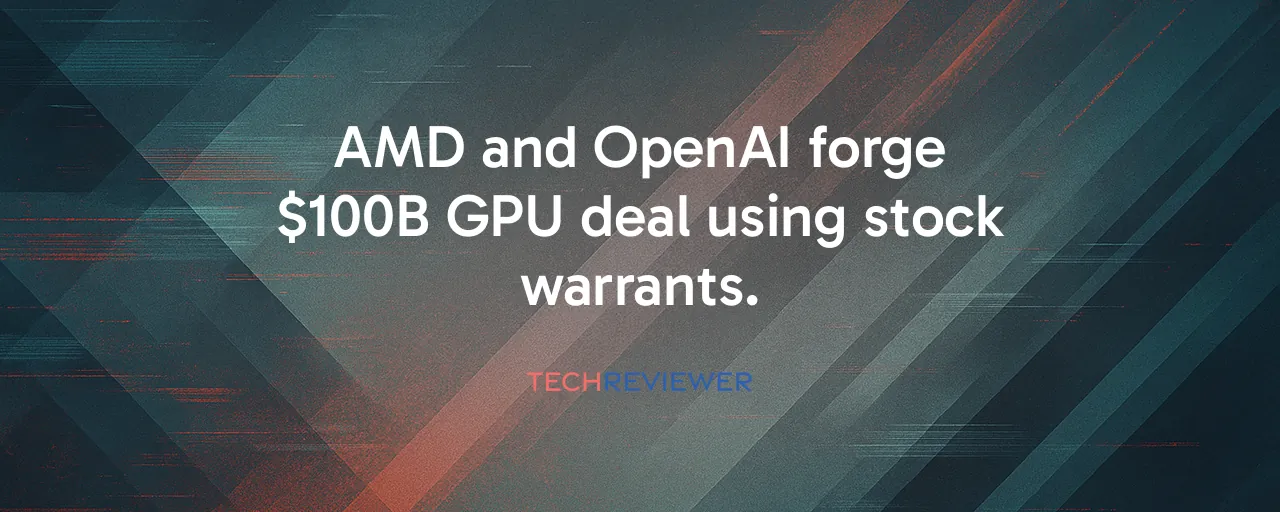A New Playbook for AI Hardware Deals
When AMD and OpenAI announced their partnership on October 7, 2025, the tech world witnessed a financial maneuver that feels unprecedented. Instead of cash, OpenAI is paying for billions in AMD Instinct GPUs and 6 gigawatts of compute capacity with up to 160 million AMD stock warrants. These warrants, vesting as AMD's stock hits specific price targets, could be worth $100 billion if the share price soars to $600, a milestone implying a $1 trillion market cap. The stock jumped from $165 to $214 in a single day, signaling investor excitement.
AMD is essentially financing OpenAI's purchases through its own equity, blending high-stakes finance with cutting-edge tech. For OpenAI, it secures massive compute power without draining cash reserves. For AMD, it's a strategic gamble to cement its place in the AI accelerator race, where Nvidia holds an estimated 80-90% market share. The deal's structure raises eyebrows and sparks a bigger question: could this be the blueprint for how AI infrastructure gets built in the future?
Stock Warrants as Tech Currency
The use of stock warrants as payment stands out. OpenAI doesn't provide cash upfront; it earns AMD shares as it helps refine Instinct GPUs and meets milestones tied to stock price growth. If all goes to plan, those shares could cover the cost of GPUs and then some. Wall Street analysts, like UBS's Timothy Arcuri, suggest OpenAI might sell shares incrementally to pay AMD, turning equity into a liquid asset for infrastructure. Holding until the final tranche could yield a $100 billion payout, funding further AI ambitions.
This setup has historical echoes in vendor financing models, where companies like IBM once leased equipment to secure long-term customers. But the scale here is unprecedented. AMD shareholders face dilution if warrants are exercised, and OpenAI's bet hinges on AMD's stock climbing steadily.
Challenging Nvidia's Iron Grip
Nvidia's dominance in AI accelerators, fueled by its H100 GPUs and CUDA software ecosystem, has left competitors scrambling. AMD's Instinct GPUs, optimized for AI workloads, are a direct challenge, and OpenAI's endorsement is pivotal. By collaborating to refine AMD's hardware and ROCm software platform, OpenAI validates that these chips can handle intense large language model demands. This partnership signals to hyperscalers like Amazon Web Services and Google Cloud, who already use AMD's EPYC CPUs, that its GPUs are ready for broader adoption.
Google developed its Tensor Processing Units in-house to power AI workloads, but adoption outside its ecosystem has been limited. AMD's approach leverages an external AI leader to drive market credibility. The challenge remains: AMD's ROCm platform lags behind Nvidia's CUDA in maturity, and developers accustomed to Nvidia's tools face a learning curve. Closing this gap could encourage cloud providers to diversify their GPU suppliers.
Real-World Wins and Pitfalls
The partnership's promise is clear, but execution is critical. AMD's existing data center footprint, built on EPYC processor sales, provides an advantage in integrating CPU-GPU solutions for cloud providers. The 6-gigawatt commitment demands massive infrastructure, from power delivery to cooling systems, pushing both companies to innovate in efficiency. OpenAI's role in optimizing AMD's chips for transformer architectures could yield significant improvements.
Challenges persist. Google's TPUs struggled to displace Nvidia GPUs because of ecosystem lock-in. Developers prefer CUDA's familiarity, and porting code to ROCm isn't trivial. AMD must also scale manufacturing through partners like TSMC to meet demand without disruptions. If the partnership falters, it risks becoming another case study of ambition falling short. Still, AMD's stock surging 30% in a day shows investors see potential.
What It Means for AI's Future
This deal could reshape how AI infrastructure is funded and built. Companies struggling to secure Nvidia GPUs amid supply constraints may find AMD's validated hardware an attractive alternative. Lower costs from increased competition could make advanced AI more accessible, benefiting developers and end users. Healthcare startups deploying AI diagnostics or researchers accelerating scientific discoveries could gain from more affordable compute resources.
The deal's complexity raises questions. The massive energy demands of 6 gigawatts highlight the need for sustainable power solutions. Regulators might scrutinize the partnership, given the concentration of AI compute power in a few players. If successful, this model could inspire other chipmakers to forge creative alliances, blending finance and innovation to fuel the AI boom. AMD and OpenAI are rewriting the rules, and the industry is watching.
